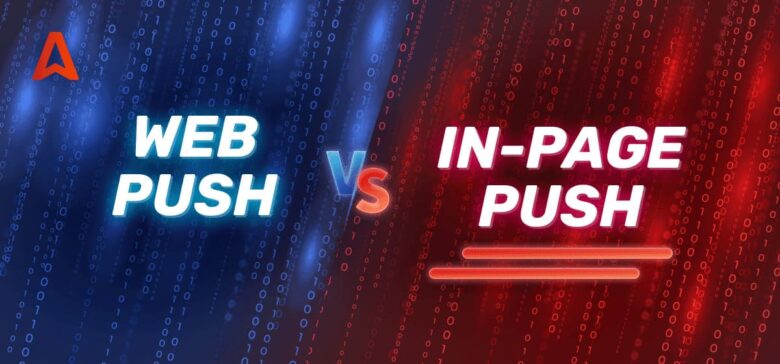Affiliate marketers and webmasters love Web Push ads… but Google doesn’t. The latest Chrome updates are gradually approaching the downward of push traffic, making advertisers and publishers looking for alternatives. One of those seems to be the In-Page Push format. Today we bring Web Push and In-Page Push in a duel to see which ad format is better for your conversion goals. The results will surprise you!
Before we jump right into it, let’s agree on some terms. The Adsterra In-Page Push is one of the multiple ad types of the innovative Social Bar ad format. Social Bar stands out with ultra-engaging templates and fully customizable push designs. But first things first, let’s define the two rivaling formats.
Both ad formats are designed to be native and non-invasive. Both of them visually appear like notifications and alerts. But the mechanics differ.
Let’s give a definition of Web Push and In-Page Push to see how they really work and differ.
What is a Web Push ad, and how does it work?
Classic Web Push ads are browser notifications. They appear on a webpage because a browser sends them. To start getting them, a user should subscribe to notifications.
Ad networks offer Web Push as an advertising format. A webmaster or publisher installs the script/code on the website, and each user who allows browser notifications will get ads related to the ad network now and then.
These notifications can reach the audience even when they are not on the web page, like when their smartphone screen is locked.
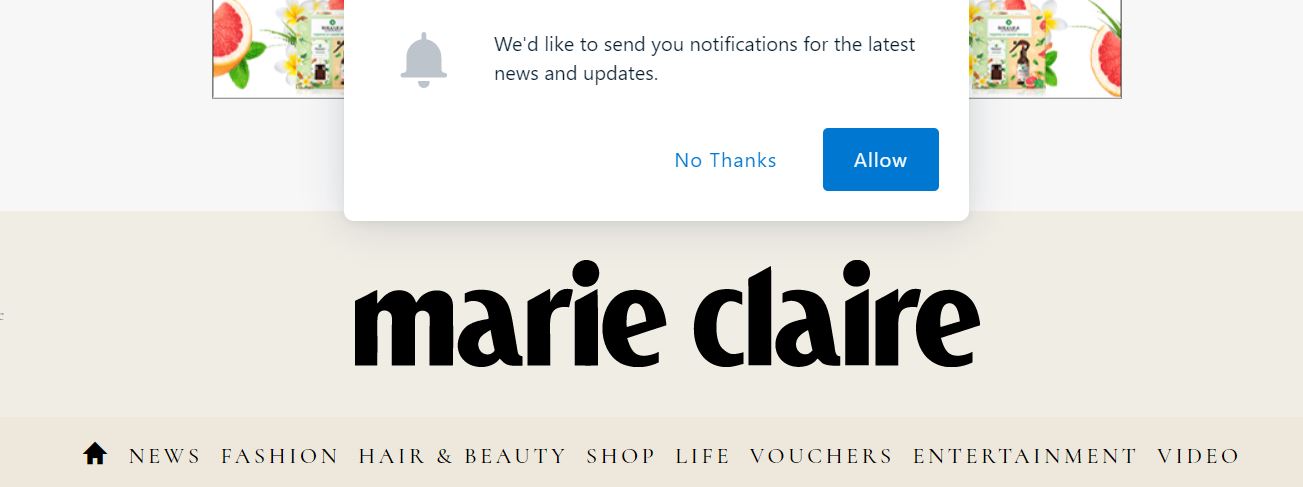
What differs a Web Push ad from any display ad?
Web Push ads are the only type of advertising that allows you to target the user lifecycle stage. Main difference between Web Push ads and display ads is their mechanics. To appear on a user’s device they need a permission (aka subscription). Thus, they allow you to target the user lifecycle stage.
Web Push vs app push
If we talk about the difference between Web Push notifications and app push notifications, is where the notifications are sent.
As you know Web Push notifications are browser-based and permission-based, and all you need is to paste and integrate script into your website. Your subscribers can sign up for notifications through mobile and web browsers.
In case of app push notifications, you need to have a mobile app and push message engine in order to send notifications.
Web Push vs onsite notifications (aka In-Page Push)
The main difference is that onsite notifications do not require prior consent of the recipient to receive them. They can be sent to the users only when they are viewing a publisher’s website as this format is part of it.
Web Push notifications allow you to communicate with your subscribers even if they are not viewing your website because they are sent through a browser.
Since Web Push ads are permission-based and it is mandatory for users to subscribe, subscribers quickly get tired of notifications. So for you as an advertiser it is important to choose the target audience segment that seems to be the most suitable and engaged. Web Push allows to work with:
- those who subscribed a long time ago;
- those who subscribed recently;
- or all users in general.
On the one hand, it’s great. But on the other hand, is it possible to call those who signed up for a long time a loyal audience? Perhaps they have not paid attention to advertising for a long time. However, advertisers still actively use such targeting.
How does an In-Page Push ad work?
In-Page Push traffic differs by default. These ads are placed on a website similarly to banners, just a line of code. They don’t require subscriptions and don’t depend on browsers. As it comes from the basic principle, they are available only on the web page, not on devices.
On the Adsterra platform, you can run multiple In-Page notifications by picking any layout that has been battle-tested and proved to convert. When you need a more compelling design, you turn to Social Bar, a push format with more impressive designs. Here are some visuals to make it all clear.
Classic In-Page Push (Adsterra layouts)
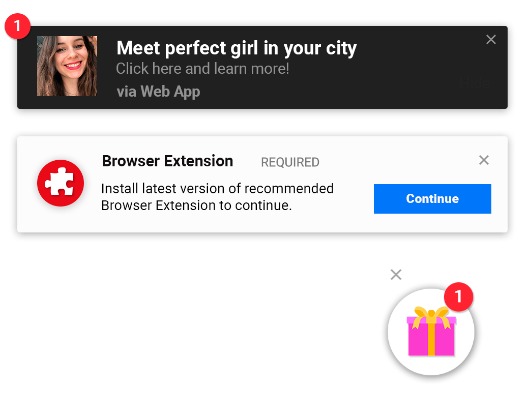
Social Bar push ads (layouts and custom designs)
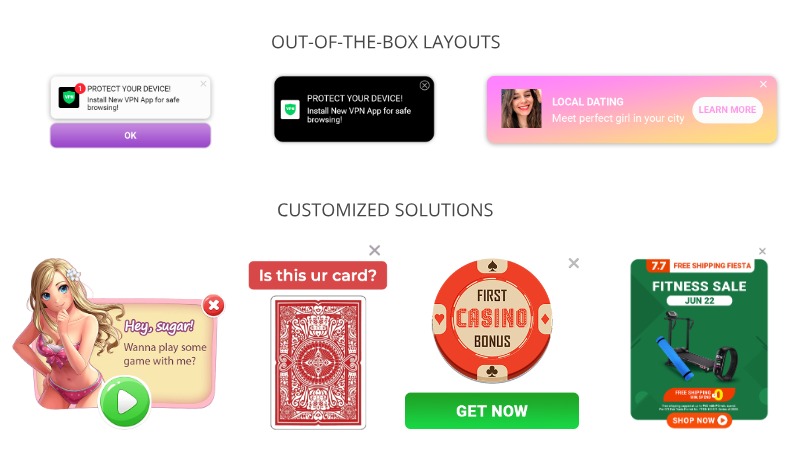
Which format to choose in 2022?
Now that we’ve found out that both formats are native and both look great on mobiles, how to decide which is better? At first, you may fall for Web Push as they perfectly imitate classic notifications and can ping users while they’re not on the website. But there’s a trick everyone seems to have missed. We’re in 2022 now, and users have changed, so changed the reasons for conversions. And former pros have become thick cons or myths.
Most of the myths about Web Push stem from its fundamental principle, the subscription requirement. But not all of them. Next, we are going to dispel the most common misconceptions about Web Push ads.
Myths and truths about Web Push ads
#1 Web Push ads have higher engagement as they reach users on their devices [MYTH]
That was one of the biggest pros of Web Push ads that won them all votes in 2018‒2019. Even when the screen is locked, the user still gets notifications. What was cool in the past has become frustrating in the present.
Users are being spammed. They ban junk emails, install ad-blockers, and show zero tolerance to privacy violence. How will they react when yet another ad alerts them on their mobiles?
#2 Chrome updates will cause a dropoff in traffic on Web Push [TRUTH]
As Google Chromium Blog states, they continue to reform the ecosystem of Web Push notifications. If Chrome 80 could show much quieter notification permission, Chrome 86 will block all notifications it detects as abusive.
Will it damage the volume of impressions? Definitely! Will it harm the quality? Probably, not. Those users who will subscribe will do it much more consciously than they used to, so traffic quality may even increase.
#3 Web Push will disappear completely in 2022 [MYTH]
The format is still in demand. If the next Chrome Update doesn’t terminate it, ads will live. Though the amount of traffic is falling gradually, there is still enough capacity to generate impressive volumes of clicks and views. Also, ads can boast of competing popunders with CPM rates.
#4 The quality of traffic on Web Push is higher than on any other format [MYTH]
This misconception is based on the principle that Web Push notifications are shown only to those who subscribed to receive them. Subscribers seem to be more loyal than occasional website guests. However, in 2022, when ads are bombarding users from every channel, the fact that a casual subscription will mean a lot to users equals to zero.
Even more, all further Google restrictions may have a positive impact on traffic. After abusive ads are blocked, only loyal users will get only relevant advertising.
#5 Classic Web Push formats still drive large traffic volumes [TRUTH]
After Google had launched Web Push notifications in 2015, the format was developing with fascinating speed. Advertising was the obvious benefit website owners and ad networks could get from them. By now, many networks can serve about 1‒3 billions impressions weekly.
#6 Looking native and fresh, Web Push boast of having great UX [MYTH]
It seems like everyone is used to seeing the same notifications of the same size and with the same layouts. Web Push ads don’t look so trustworthy and exciting anymore. They’re too mainstream to engage and a bit outdated to be native.
And combined with widgets like email subscriptions, lead magnets, they become yet another annoying pop-up.
Now that we have exposed the most common myths, we can move on to the more practical information and list facts about In-Page Push ads.
7 facts about In-Page Push ads that make them so beneficial for advertisers and affiliates
Here are the 7 core facts about the In-Page Push ads that will convince you to invest in them, for they can ramp up sales. Again, we talk about both the classic In-Page Push format and its advanced version, Social Bar.
1. All traffic is yours without exceptions
It means you don’t cut off iOS users who don’t usually get Web Push ads. You also don’t depend on subscriptions. Better reach, better profit.
2. Up to 10-30 times higher CTRs
Previous generations of In-Page Push ads could do nothing but display pictures and headlines. Now you can trigger users with several types of icons, social widgets, CTA buttons, etc.
3. Five times more conversions with In-Page Push
Conversion flow is much shorter here. You can adjust your Social Bar ads to collect emails or other information right on the ad widget. Here, on the picture below, users can type in their emails without extra clicks.
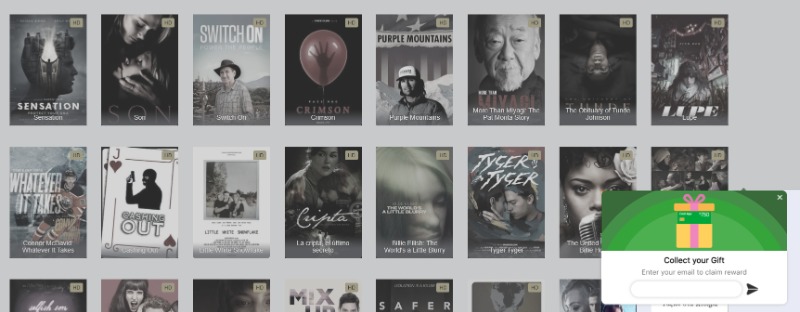
4. Layouts that proved to convert
You don’t spend time designing, you take one of the battle-tested layouts and add your visuals.
5. Customization is the key to the user’s heart
While standard In-Page Push keeps its discreet design, Social Bar’s capacities are unlimited. Your message can engage users like an Instagram Story or a TikTok. Want the ad to rotate, twinkle, or react to click? You can design it yourself or ask Adsterra designers.
6. More and more traffic each day
Unlike Web Push ads that are getting weaker, In-Page formats gain more and more webmasters and publishers from Tier1, Tier2, and Tier 3.
7. Mobile users fall for In-Page Push
Advertising and marketing trends state that users are becoming more and more sophisticated. They show intolerance to spammy ads and annoying alerts. What they fall for is UX-friendly, personalized information that is catchy but non-intrusive. Social Bar and its subformat, In-Page Push units, are made to meet user expectations…and exceed them 🙂
5 reasons why publishers monetize more with In-Page Push and Social Bar
1. No ad-block! Your users won’t miss ads, and you won’t lose money. Remember facing ad discrepancy with Web Push? Now you can forget about it.
2. One-minute install. You take the line of code and place it anywhere on the web page: no hassle and zero coding.
3. You can drive iOS traffic, and these are the most highly-paid users.
4. Higher profits. In-Page Push notifications are on their acme of demand. Top advertisers and affiliates are eager to promote with this format.
5. Elegant and user-friendly ads. And that means a lot cause users are tired of gigantic ads.
What verticals are already making money with In-Page Push?
The first vertical that started boosting CTR and ROI was Dating. Invitation to a private chat or a secret story sent by a lovely girl left watchers no chance but to click. Next came Sweepstakes and VPNs. Here and now, top verticals that make money with In-Page Push ads are:
- Utility: VPN, Antivirus, Boosters, Cleaners
- E-commerce
- Sweepstakes
- Dating
- Apps
- PIN submits (Mobile Content)
- iGaming and Sports
- Games
Web Push VS In-Page Push. A 12-round fight
Earlier in this post, we agreed to collide the two rivaling formats to find out which could invest more in your conversions, Web Push or In-Page Push. Now it’s fight time!
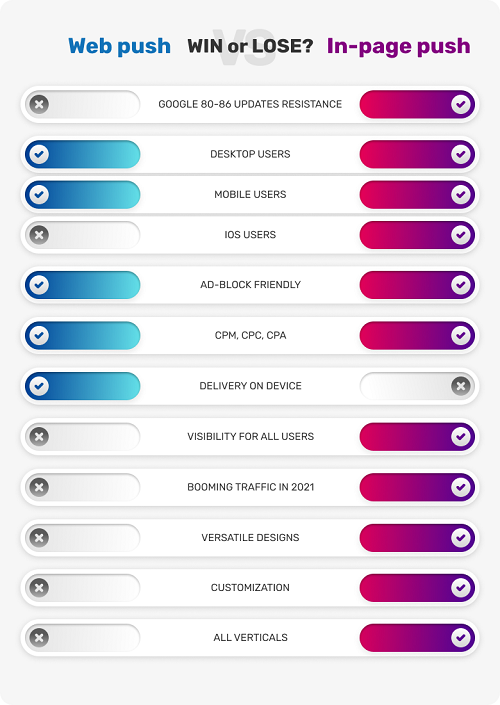
How can advertisers and affiliates use In-Page Push and Social Bar units on Adsterra?
Following the latest Google updates, Adsterra will be gradually converting Web Push traffic into the In-Page Push. All traffic sources will migrate painlessly and automatically. There won’t be any traffic loss, and you can always check up with the Traffic Chart.
So, how can you start running ads?
To drive conversions and sales with the In-Page Push format, you should bear in mind that you have unlimited design opportunities and a set of selected layouts.
- #1 STEP — sign in or sign up as an advertiser.
- #2 STEP — pick Create campaign.
- #3 STEP — pick Push Ads for notifications or Social Bar for rich designs.
- #4 STEP — see all layouts and download your visuals to make outstanding creatives.
To make sure your ads are compelling, please read this definitive guide to creatives from our Head of CPA.
Fight results: Web Push or In-Page Push?
Just like banner ads that are still generating massive traffic, Web Push ads are a profitable and robust format. But totally replaceable in the meantime. The hype around them is about to fade, and the nearest In-Page successor has already built up a new reality that is much more powerful and prospective.
We at Adsterra keep pace with trends and market demands. With publishers gradually growing In-Page traffic, we can provide our advertisers with users interested in any vertical: Mobile utility, Carrier Billing, E-commerce, Sweepstakes, iGaming and Sports, and many more. Which product or offer are you going to promote? On CPM or CPA? Our managers are world-class experts ready to advise on the best strategy.
